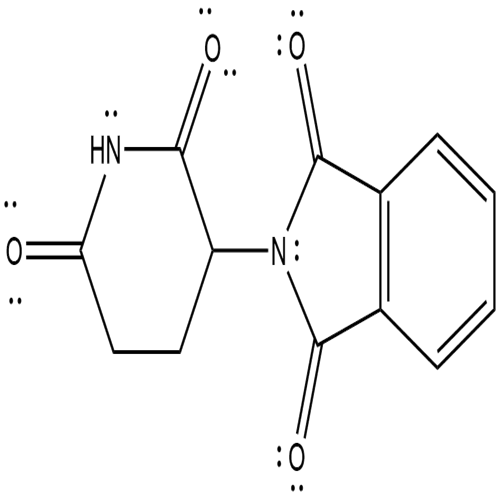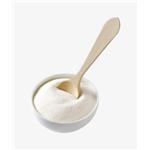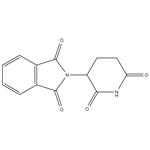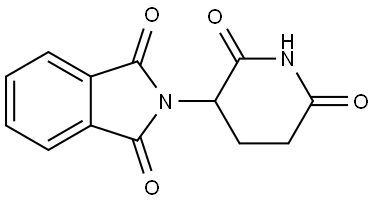Thalidomide
- CAS No.
- 50-35-1
- Chemical Name:
- Thalidomide
- Synonyms
- 2-(2,6-Dioxopiperidin-3-yl)isoindoline-1,3-dione;Neo;k17;Celgene;Contergan;α-Phthalimidoglutarimide;2-(2,6-dioxopiperidin-3-yl)-1H-isoindole-1,3(2H)-dione;K 17;E-217;Sedin
- CBNumber:
- CB0311476
- Molecular Formula:
- C13H10N2O4
Lewis structure

- Molecular Weight:
- 258.23
- MDL Number:
- MFCD00153873
- MOL File:
- 50-35-1.mol
- MSDS File:
- SDS
| Melting point | 269-271°C |
|---|---|
| Boiling point | 401.48°C (rough estimate) |
| Density | 1.2944 (rough estimate) |
| refractive index | 1.5300 (estimate) |
| storage temp. | Keep in dark place,Sealed in dry,Room Temperature |
| solubility | 45% (w/v) aq 2-hydroxypropyl-β-cyclodextrin: 0.6 mg/mL |
| form | White solid |
| pka | 10.70±0.40(Predicted) |
| color | white |
| Water Solubility | <0.1 g/100 mL at 22 ºC |
| λmax | 300nm(lit.) |
| Merck | 14,9255 |
| Stability | Stable. Combustible. Incompatible with strong oxidizing agents. |
| InChIKey | UEJJHQNACJXSKW-UHFFFAOYSA-N |
| CAS DataBase Reference | 50-35-1(CAS DataBase Reference) |
| NCI Dictionary of Cancer Terms | thalidomide |
| FDA UNII | 4Z8R6ORS6L |
| NCI Drug Dictionary | thalidomide |
| ATC code | L04AX02 |
| Proposition 65 List | Thalidomide |
| NIST Chemistry Reference | Phthalimide, n-(2,6-dioxo-3-piperidyl)-(50-35-1) |
| EPA Substance Registry System | Thalidomide (50-35-1) |
SAFETY
Risk and Safety Statements
| Symbol(GHS) |   GHS06,GHS08 |
|||||||||
|---|---|---|---|---|---|---|---|---|---|---|
| Signal word | Danger | |||||||||
| Hazard statements | H301-H312-H360D | |||||||||
| Precautionary statements | P201-P202-P264-P280-P301+P310-P302+P352+P312 | |||||||||
| Hazard Codes | T | |||||||||
| Risk Statements | 46-61-21-25-62-22 | |||||||||
| Safety Statements | 53-22-26-36/37/39-45 | |||||||||
| RIDADR | UN 2811 6.1/PG 3 | |||||||||
| WGK Germany | 3 | |||||||||
| RTECS | TI4375000 | |||||||||
| HazardClass | 6.1(b) | |||||||||
| PackingGroup | III | |||||||||
| HS Code | 29337900 | |||||||||
| Toxicity | LD50 oral in mouse: 2gm/kg | |||||||||
| NFPA 704 |
|
Thalidomide price More Price(47)
| Manufacturer | Product number | Product description | CAS number | Packaging | Price | Updated | Buy |
|---|---|---|---|---|---|---|---|
| Sigma-Aldrich | PHR3249 | Thalidomide pharmaceutical secondary standard, certified reference material | 50-35-1 | 500MG | $172 | 2024-03-01 | Buy |
| Sigma-Aldrich | 1652500 | Thalidomide United States Pharmacopeia (USP) Reference Standard | 50-35-1 | 200mg | $519 | 2024-03-01 | Buy |
| Sigma-Aldrich | 585970 | (±)-Thalidomide Selective inhibitor of TNF-α biosynthesis. | 50-35-1 | 100mg | $155 | 2022-05-15 | Buy |
| TCI Chemical | T2524 | (±)-Thalidomide >98.0%(HPLC)(N) | 50-35-1 | 1g | $184 | 2024-03-01 | Buy |
| TCI Chemical | T2524 | (±)-Thalidomide >98.0%(HPLC)(N) | 50-35-1 | 5g | $460 | 2024-03-01 | Buy |
Thalidomide Chemical Properties,Uses,Production
Glutamic acid derivatives
Thalidomide is a kind of synthetic glutamic acid derivatives. At room temperature, it is a kind of white crystalline powder, and is odorless, tasteless, and slightly soluble in water, methanol, ethanol or acetone, highly soluble in dimethylformamide or pyridine, but insoluble in ether, chloroform or benzene.
At 1950s, Germany developed the drug mainly for treating epilepsy. However, due to the lack of efficacy, then it is further used as an adjunct for sleeping while also widely used as antiemetic drug for pregnant women during their pregnancy.
At early 1960s, thalidomide incident---there had been a lot of reports about birth defect caused by thalidomide (such as: short limb malformations, bone defect, ear missing, cleft lip, heart and gastrointestinal tract abnormalities, etc.). Thereby, it was further prohibited by many countries, and subjected to withdrawal from the pharmaceutical market; but scientists did not totally negate thalidomide and continued to carry out in-depth research; there has been much encouraging and promising progress on the pharmacologic mechanisms of immunity, anti-inflammatory, and anti-angiogenic as well as the clinical treatment of various kinds of difficult disease, making people gain new understanding of the functions of thalidomide.
Since the 1970s, with the emergence of the various research progresses of leprosy, rheumatism and various types of cancer, Israel dermatologists had applied thalidomide as a sedative for patients of erythema nodosum leprosy and obtain rapid alleviation of symptoms. After that many patients of erythema nodosum leprosy had received good therapeutic effects. In1998, the FDA approved thalidomide for the treatment of erythema nodosum leprosy.
In 2004, during the American Society of Hematology annual meeting, RaJkumar from the US Mayo Clinic reported the progress of two studies about using thalidomide and its analogs (lenalidomide) in first-line treatment of multiple myeloma. Both thalidomide and its analogs, lenalidomide are effective in the treatment of multiple myeloma with lenalidomide having a better effect than thalidomide.
In May 2006, the US FDA approved it for the treatment of multiple myeloma.
The above information is edited by the chemicalbook of Dai Xiongfeng.
Treatment of rheumatism
Foreign scholars have reported that when using thalidomide for treatment of 7 rheumatoid patients who can’t be cured by various kinds of anti-inflammatory drugs and immune inhibition, the symptoms were alleviated in most cases within a few weeks at the dose in 400~600mg/d. All patients have their erythrocyte sedimentation rate and rheumatoid factor titers either be normalized or be decreased, wherein 1 case of rheumatoid nodules disappeared at 12 weeks. Someone have ever combined thalidomide with methotrexate for treating 7 cases of refractory rheumatoid arthritis, wherein in 5 cases of patient who persists in treatment, 4 cases obtained alleviated joints tenderness and reduced joints swelling feeling within 3 to 9 months.
Thalidomide to treat rheumatism diseases as follows:
1. Behcet's disease.
2. Systemic lupus erythematosus.
3. Rheumatoid arthritis.
4. Erythema nodosum, Crohn's disease.
5. Scleroderma: at 12 weeks after the start of treatment, it can significantly alleviate the symptoms of gastroesophageal reflux, heal duodenal ulcer and lead to hypopigmentation.
6. Adult Still's disease.
7. Refractory ankylosing spondylitis, multiple myeloma (MM).
Clinical treatment of rheumatism should start from small dose at 25--50mg/day per night, gradually increase the amount to 100--200mg/day with the maximum not exceeding 400mg/day.
Side effects
Adverse reactions during the treatment using thalidomide include: drowsiness, dizziness, drowsiness, headache, constipation, nausea, vomiting, dry mouth, dry skin, erythema and papules and vesicular transient rash; but they usually are not serious and can disappear after termination of administration.
The adverse reactions that should be noted is multiple neuritis with the main symptom being a surface or deep sensory loss and muscle weakness; the occurrence of symptoms is not proportional to the dose and duration; the time when the symptoms began to appear also varies greatly; for the cases without treatment termination, such symptoms are irreversible. In addition, leukopenia, abnormal liver function as well as the well-known teratogenic effects also should be taken care. Other rare side effects include bradycardia, edema, abnormal blood clotting, kidney failure, pneumonia, paresthesia, and hypothyroidism.
Chemical Properties
White powder.
Uses
It is used as sedative and has certain efficacy in treating various types of leprosy reactions such as fever, erythema nodosum, neuralgia, joint pain, and swollen lymph nodes but has no treatment effect on leprosy.
Description
(±)-Thalidomide is an immunomodulatory compound with diverse biological activities, including anticancer, anti-inflammatory, and teratogenic properties. It prevents polymorphonuclear leukocyte (PMN) chemotaxis when used at concentrations of 1, 10, and 100 μg/ml. (±)-Thalidomide increases IL-2-induced proliferation and IFN-γ production in primary human T cells in vitro. It enhances natural killer (NK) cell-mediated cytotoxicity in MM.1S multiple myeloma cells. Thalidomide (4 mg/animal) reduces lung IL-6, TGF-β, VEGF, angiopoietin-1, angiopoietin-2, and collagen type Iα1 expression, inhibits pulmonary angiogenesis, and attenuates fibrosis in a mouse model of bleomycin-induced pulmonary fibrosis. It induces apoptosis in primary human embryonic fibroblasts (EC50 = 8.9 μM) and induces limb and eye defects in chicken embryos (EC50 = 50 μg/kg egg weight). Formulations containing thalidomide have been used in the treatment of multiple myeloma and erythema nodosum leprosum (ENL) in non-pregnant individuals.
Description
Thalidomide is a glutamic acid derivative first synthesized in
1953 by Swiss Pharmaceuticals; however, due to lack of pharmacological
effects, the development was discontinued. In
1954, Chemie Grünenthal, a German company, undertook the
development of thalidomide and, in 1957, thalidomide was
marketed as an anticonvulsant for the treatment of epilepsy.
Since the drug caused drowsiness, it was also marketed as
a sedative. Thalidomide was considered a safe and effective
drug that caused deep sleep with no hangover, and by the end
of the 1950s, 14 pharmaceutical firms were marketing the drug
in countries of Europe, Asia, Australia, the Americas, and Africa.
However, the drug was never approved for use in the United
States due to concerns about the safety of the drug raised by
Frances Kelsey, MD, a drug reviewer at Food and Drug
Administration (FDA). The approval process was delayed due
to her repeated requests for additional safety information from
William S. Merrell Company, the licensee of Chemie Grünenthal
that applied to market thalidomide in the United States.
Dr Kelsey’s concerns were mostly related to thalidomideinduced
neuropathy. Previous research had shown that drugs
that irritated nerves in adult rabbits could have adverse effects
on growth and cause deformities in fetal rabbits. During this
time, the use of the drug became widespread and, because it
was effective in alleviating morning sickness, it became popular
among pregnant women. In 1961, two physicians, William G.
McBride, MD of Australia and Widulind Lenz, MD of Germany,
associated the increase in malformation of the limbs (phocomelia)
and other congenital abnormalities with the use of
thalidomide by pregnant women. By late 1961, birth defects in
more than 12 000 children were associated with thalidomide
use, which forced companies to withdraw the drug worldwide.
The birth defects were due to thalidomide teratogenecity:
mainly phocomelia and malformation of ears, often accompanied
by malformation of the internal organ. In 1965, an
experimental use of thalidomide in patients with lepromatous
leprosy proved to be effective in treating painful skin lesions
that resulted from the inflammatory complications of leprosy.
In fact, experimental use of thalidomide had been extended to
a variety of diseases with various degrees of success, including
refractory rheumatoid arthritis, Crohn’s disease, human
immunodeficiency virus (HIV)-1 associated Kaposi’s sarcoma,
cutaneous lupus, prostate cancer, and colorectal cancer. In
1998, the FDA approved Thalomid as a therapy for erythema
nodosum leprosum (ENL), or leprosy. Subsequently in 2006,
Thalomid in combination with dexamethasone was approved
for treatment of multiple myeloma.
Chemical Properties
White Powder
Originator
Contergan,Grunenthal,Germany
Uses
antiinfective (topical)
Uses
Thalidomide was formerly used as a sedative-hypnotic drug. It is used in the treatmentof leprosy. Recent studies indicate that thecompound may be effective against cancer.
Uses
Thalidomide was prescribed as an anti-nausea agent to help pregnant women with morning sickness in the late 1950s. It was found to be a potent teratogen, causing many different forms of birth defects and was withdrawn from the market. Thalidomide and synthetic analogs have recently been proven effective in treating inflammation associated with diseases such as leprosy, arthritis and Crohn’s disease, and in cancers such as multiple myeloma. The direct target for the teratogenicity of thalidomide was not discovered until 2010, when it was found that it interacts directly with the protein cereblon (CRBN; IC50 = 8.5 nM), a ubiquitously-expressed E3 ligase. Binding of thalidomide analogs to CRBN-DNA damage binding protein-1 complexes account for the immunomodulatory and antiproliferative effects of these compounds.[Cayman Chemical]
Uses
Inhibits FGF-induced angiogenesis. Inhibits replication of human immunodeficiency virus type 1. Teratogenic sedative. There is now a growing clinical interest in Thalidomide, and it is introduced as an immunomodulatory agent used primarily in combination with dexamethasone to treat multiple myeloma.
Indications
Thalidomide (Thalomid) is a derivative of glutamic acid that is chemically related to glutethimide. It exerts a number of biological effects as an immunosuppressive, antiinflammatory, and antiangiogenic agent, yet its mechanisms of action have not been fully elucidated. Thalidomide potently inhibits production of tumor necrosis factor (TNF) and interleukin (IL) 12, and its effect on these and other cytokines may account for some of its clinical effects.
Definition
ChEBI: A dicarboximide that is isoindole-1,3(2H)-dione in which the hydrogen attached to the nitrogen is substituted by a 2,6-dioxopiperidin-3-yl group.
Manufacturing Process
26 g of N-phthalyl glutaminic acid anhydride are melted with 12 g of urea in an oil bath at 170-180°C until the reaction is completed, which takes about 20 min. The reaction takes place with violent evolution of carbon dioxide and ammonia. After cooling, the reaction product is recrystallised by fractionation from 95% alcohol, and the first fraction may contain phthalic acid derivatives. The required product N-(2,6-dioxo-3-piperidyl)-phthalimide melts at 269- 271°C. The yield is about 65-70% of the theoretical.
brand name
Algosediv;Asidon;Bonbrain;Contergan;Distaval;Funed;Glutanon;Hippuzon;Imidan;Isomin;Kevadone;Nerufatin;Neurosedyn;Pantosedive;Pro-ban;Quetimid;Sanodormin;Sedalis;Sedoval;Shinaito;Shinnibrol;Sleepan;Softenil;Softenon;Talimol;Tlargan;Yodomin.
Therapeutic Function
Sedative, Hypnotic, Antiarthritic
World Health Organization (WHO)
Notwithstanding the highly potent teratogenic action of thalidomide, this drug retains a place in the treatment of reactional lepromatous leprosy and several serious dermatological conditions refractory to other treatment. In many countries, the competent authorities have granted exemption from licensing requirements to enable doctors to obtain limited supplies of thalidomide under strictly controlled circumstances for use in named patients. Arrangements have also been made by some national drug regulatory authorities for thalidomide to be used in institutions concerned with the treatment of leprosy.
Synthesis Reference(s)
Synthetic Communications, 33, p. 1375, 2003 DOI: 10.1081/SCC-120018698
General Description
Needles or white powder.
Air & Water Reactions
Insoluble in water.
Reactivity Profile
Organic amides/imides, such as Thalidomide, react with azo and diazo compounds to generate toxic gases. Flammable gases are formed by the reaction of organic amides/imides with strong reducing agents. Amides are very weak bases (weaker than water). Imides are less basic yet and in fact react with strong bases to form salts. That is, they can react as acids. Mixing amides with dehydrating agents such as P2O5 or SOCl2 generates the corresponding nitrile. The combustion of these compounds generates mixed oxides of nitrogen (NOx).
Health Hazard
Thalidomide is a strong teratogen. Exposureto this compound during the first trimesterof pregnancy resulted in deformities inbabies. Infants born suffered from ameliaor phocomelia, the absence or severe shortening of limbs. Administration of thalidomide in experimental animals caused fetaldeaths, postimplantation mortality, and specific developmental abnormalities in theeyes, ear, central nervous system, musculoskeletal system, and cardiovascular system. Several thousand children were affected.The drug has been withdrawn from themarket.Thalidomide is usually administeredorally. Its toxicity is dose dependent. Someother effects are drowsiness, constipation andrash and nerve damage in the arms and legs.Interest in thalidomide resurged in recentyears because of its antitumor activity in thetreatment of multiple myeloma (Oxberry andJohnson 2006). The compound is an inhibitorof angiogenesis, that is, it prevents formationof new blood vessels in tumors. Also, it hasbeen found to be effective in treating AIDS-related Kaposis sarcoma.
Fire Hazard
Flash point data for Thalidomide are not available; however, Thalidomide is probably combustible.
Biological Activity
Teratogen, sedative-hypnotic with inherent anti-inflammatory properties. A selective inhibitor of tumor necrosis factor α (TNF- α ) synthesis.
Biochem/physiol Actions
(±)-Thalidomide selectively inhibits biosynthesis of tumor necrosis factor α (TNF-α). It also functions as an inhibitor of angiogenesis, an immunosuppressive agent, a sedative and a teratogen. Furthermore, thalidomide is known to exhibit antitumor functions in refractory multiple myeloma.
Mechanism of action
Its absorption from the gastrointestinal tract is slow, with peak plasma levels being reached after 3 to 6 hours. It appears to undergo nonenzymatic hydrolysis in the plasma to a large number of metabolites.The elimination half-life is approximately 9 hours.
Clinical Use
Thalidomide is approved for use in the United States for the treatment of cutaneous manifestations of erythema nodosum leprosum, a potentially lifethreatening systemic vasculitis that occurs in some patients with leprosy.Although not approved for other indications, thalidomide has also been shown to be very effective in the management of Beh?et’s disease, HIVrelated mucosal ulceration (aphthosis), and select cases of lupus erythematosus.
Side effects
Thalidomide is a highly teratogenic drug, characteristically
causing phocomelia (aplasia of the midportions of
the limbs). Even a single dose may cause fetal malformation.
Thalidomide should be prescribed to women of
childbearing potential only when no acceptable alternative
exists. Because it is not known whether thalidomide
is present in the ejaculate of males receiving the drug,
male patients must use a latex condom when engaging in
sexual activity with women of childbearing potential.
Other side effects of thalidomide may include sedation
(in fact, thalidomide was originally marketed in
Europe as a sleeping aid), constipation, and peripheral
neuropathy, which may be permanent.
Safety Profile
Poison by ingestion. Moderately toxic by skin contact and intraperitoneal routes. Human teratogenic effects by ingestion: developmental abnormalities of the musculoskeletal and cardiovascular systems. Experimental reproductive effects. Questionable carcinogen with experimental tumorigenic and teratogenic data. Human mutation data reported. It was commonly used as a prescription drug in Europe in the late 1950s and early 1960s. Its use was dscontinued because it was lscovered to cause serious congenital abnormalities in the fetus, notably amelia and phocomelia (absence or deformity of the limbs, including hands and feet) when taken by a woman during early pregnancy. When heated to decomposition it emits toxic fumes of NOx. Used as a sedative and hypnotic.
Drug interactions
Potentially hazardous interactions with other drugs
Thalidomide enhances the effects of barbiturates,
alcohol, chlorpromazine and reserpine.
Use with caution with other drugs that can cause
peripheral neuropathy.
Metabolism
Thalidomide is metabolised almost exclusively by nonenzymatic hydrolysis. In plasma, unchanged thalidomide
represents 80
% of the circulatory components.
Unchanged thalidomide was a minor component
(<3
% of the dose) in urine. In addition to thalidomide,
hydrolytic products N-(o-carboxybenzoyl) glutarimide
and phthaloyl isoglutamine formed via non-enzymatic
processes are also present in plasma and in urine.
storage
Store at RT
Toxicity evaluation
The mechanism of teratogenecity of the thalidomide is not clearly understood; however, recent studies have shed some light on the potential mechanism. CRBN has been identified as a thalidomide-binding protein. The teratogenic effects start with binding of thalidomide to CRBN and inhibiting the associated ubiquitin ligase activity.Many E3 ubiquitin ligases are important for various physiological processes such as cell cycle regulation, carcinogenesis, immune response, and development. It has been shown that CRBN forms an E3 ubiquitin ligase complex with damaged DNA binding protein 1 (DDB1) and Cullin-4A (Cul4A), which are important factors for expression of the fibroblast growth factor Fgf8 in zebra fish and chicks as well as the limb outgrowth. In thalidomide-treated zebra fish embryos, formation of proximal endoskeletal disc of the pectoral fin was severely inhibited and the otic vesicle size was significantly reduced. Pectoral fins and otic vesicles in fish share common molecular pathways with tetrapod limbs and ears development. Down-regulation of the CRBN complex causes similar developmental defects in zebra fish. Thalidomide does not cause limb malformations in rodents but does in rabbits, monkeys. In pregnant rats, thalidomide can cause other types of developmental defects such as vertebral column, rib, and eye malformation. There is very strong conservation of the amino acid sequence of CRBN between rat, rabbit, monkey, mouse and human and has been shown that they can bind to thalidomide. The role and importance of CRBN in different species have not been identified; therefore, the degree of teratogenecity could depend in part on the nature of the protein substrates that are modified by CRBN activity during embryonic development. There are some species differences in teratogenecity between thalidomide and its close analogs.
References
1) Ito et al. (2010), Identification of a primary target of thalidomide teratogenicity; Science, 327 1345 2) Weglicki et al. (1993), Inhibition of tumor necrosis factor-alpha by thalidomide in magnesium deficiency; Mol. Cell. Biochem., 129 195 3) D’Amato et al. (1994), Thalidomide is an inhibitor of angiogenesis ; Proc. Natl. Acad. Sci. USA, 91 4082
Thalidomide Preparation Products And Raw materials
| Supplier | Tel | Country | ProdList | Advantage | |
|---|---|---|---|---|---|
| Henan Bao Enluo International TradeCo.,LTD | +86-17331933971 +86-17331933971 | deasea125996@gmail.com | China | 2503 | 58 |
| Henan Fengda Chemical Co., Ltd | +86-371-86557731 +86-13613820652 | info@fdachem.com | China | 7786 | 58 |
| Henan Tianfu Chemical Co.,Ltd. | +86-0371-55170693 +86-19937530512 | info@tianfuchem.com | China | 21691 | 55 |
| ATK CHEMICAL COMPANY LIMITED | +undefined-21-51877795 | ivan@atkchemical.com | China | 32480 | 60 |
| career henan chemical co | +86-0371-86658258 | sales@coreychem.com | China | 29914 | 58 |
| Hubei Jusheng Technology Co.,Ltd. | 18871490254 | linda@hubeijusheng.com | CHINA | 28180 | 58 |
| Standardpharm Co. Ltd. | 86-714-3992388 | overseasales1@yongstandards.com | United States | 14336 | 58 |
| Chongqing Chemdad Co., Ltd | +86-023-61398051 +8613650506873 | sales@chemdad.com | China | 39916 | 58 |
| CONIER CHEM AND PHARMA LIMITED | +8618523575427 | sales@conier.com | China | 47465 | 58 |
| Shaanxi Dideu Medichem Co. Ltd | 18192627656 | 1012@dideu.com | China | 3422 | 58 |
View Lastest Price from Thalidomide manufacturers
| Image | Update time | Product | Price | Min. Order | Purity | Supply Ability | Manufacturer | |
|---|---|---|---|---|---|---|---|---|
 |
2024-04-24 | Thalidomide
50-35-1
|
US $690.00-670.00 / kilograms | 10kilograms | 99% | 100tons | Hebei Dangtong Import and export Co LTD | |
 |
2024-04-20 | Thalidomide
50-35-1
|
US $35.00-1.10 / kg | 1kg | 99% | g-kg-tons, free sample is available | Henan Fengda Chemical Co., Ltd | |
 |
2024-03-16 | Thalidomide
50-35-1
|
US $0.00 / KG | 100g | 98%+ | 100kg | WUHAN CIRCLE POWDER TECHNOLOGY CO.,LTD |
-

- Thalidomide
50-35-1
- US $690.00-670.00 / kilograms
- 99%
- Hebei Dangtong Import and export Co LTD
-

- Thalidomide
50-35-1
- US $35.00-1.10 / kg
- 99%
- Henan Fengda Chemical Co., Ltd
-

- Thalidomide
50-35-1
- US $0.00 / KG
- 98%+
- WUHAN CIRCLE POWDER TECHNOLOGY CO.,LTD





